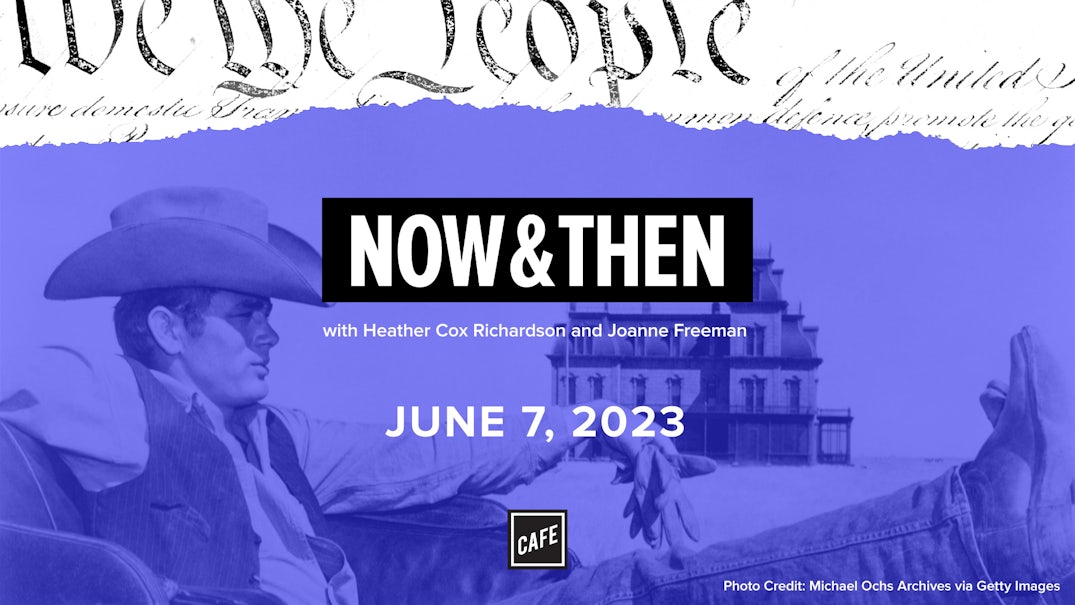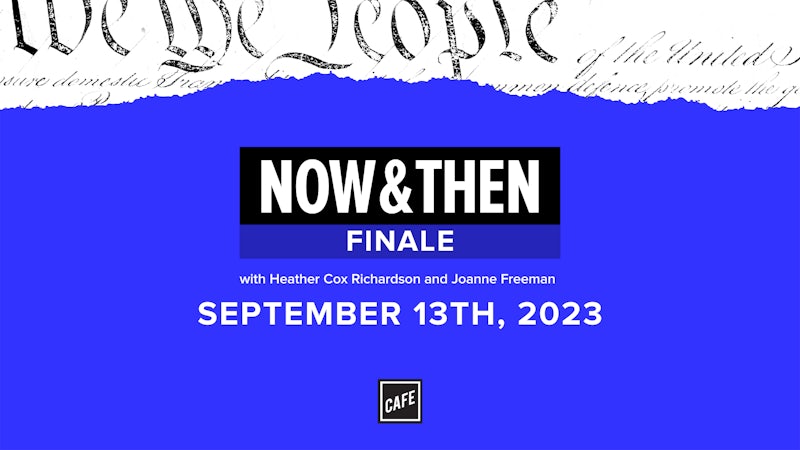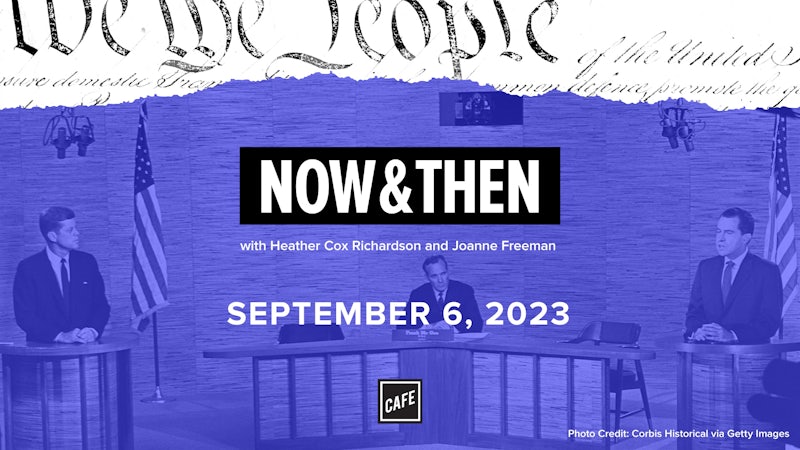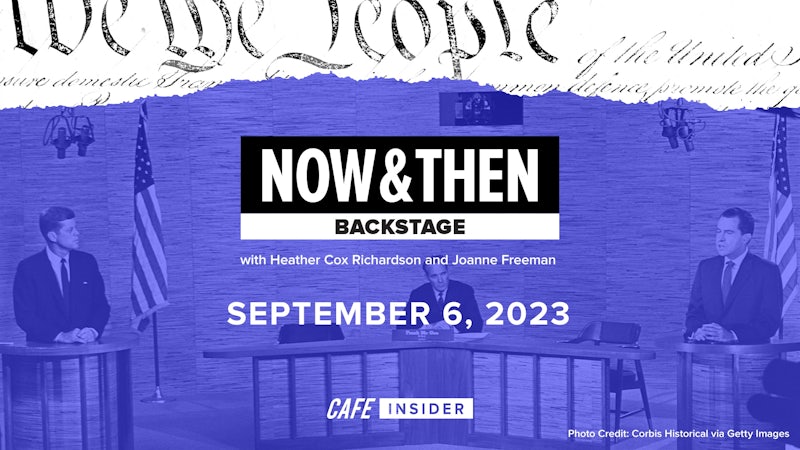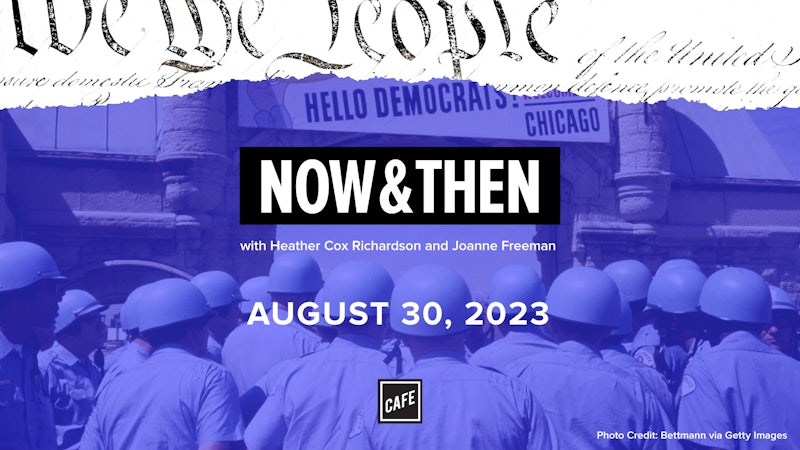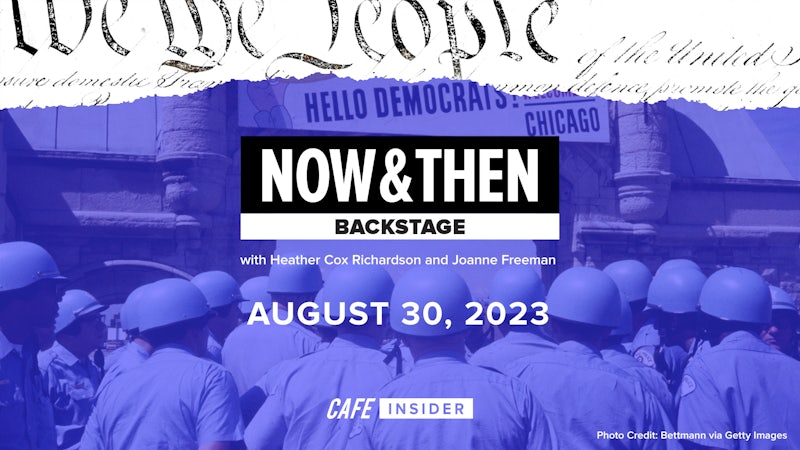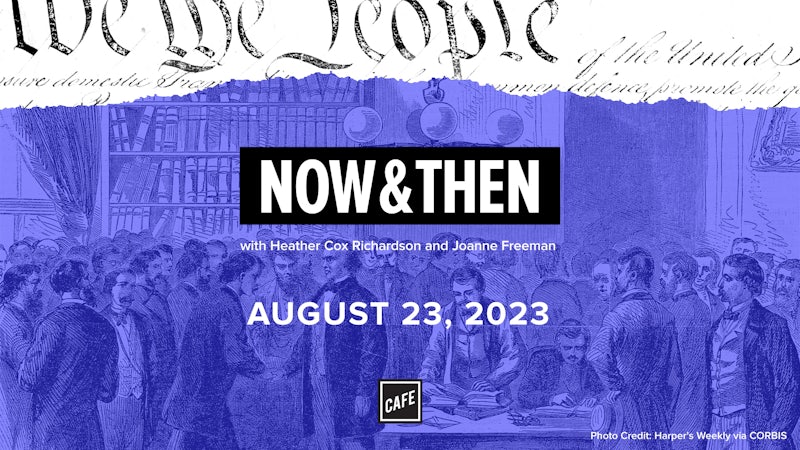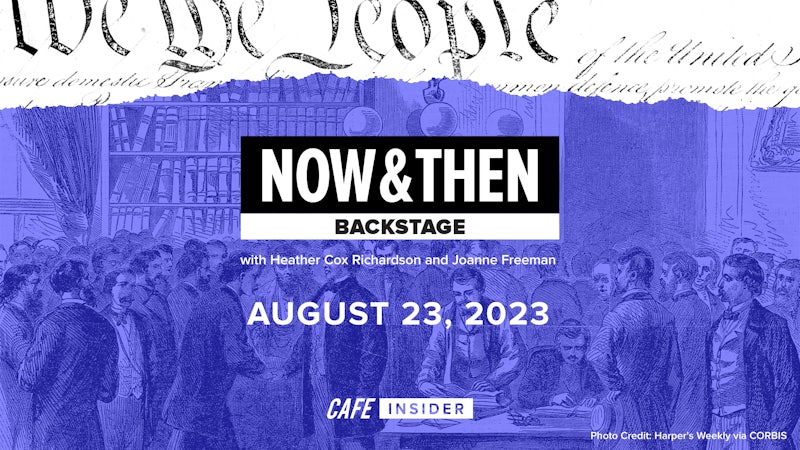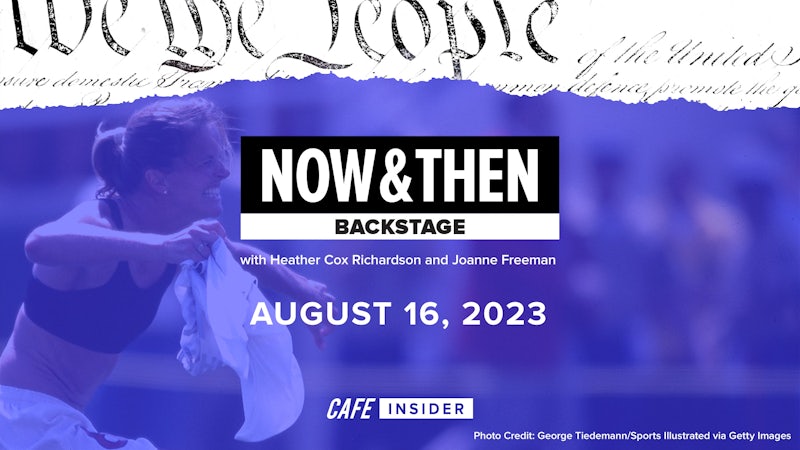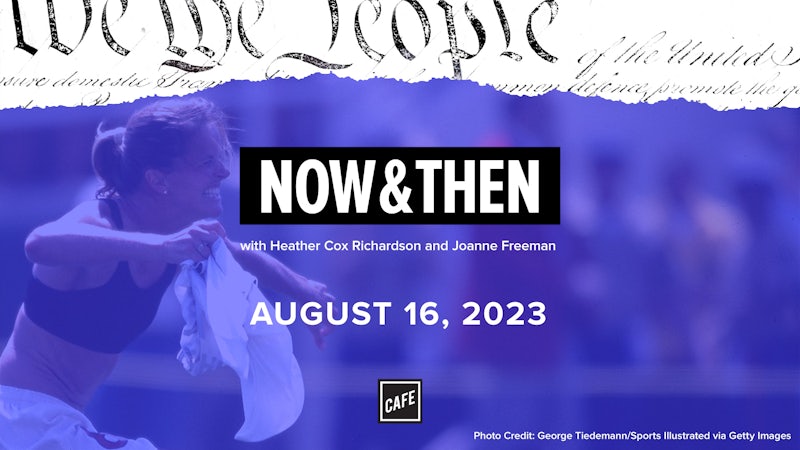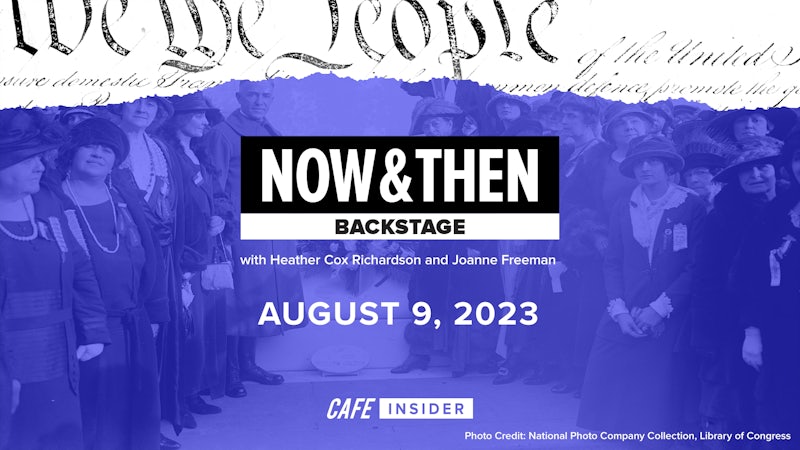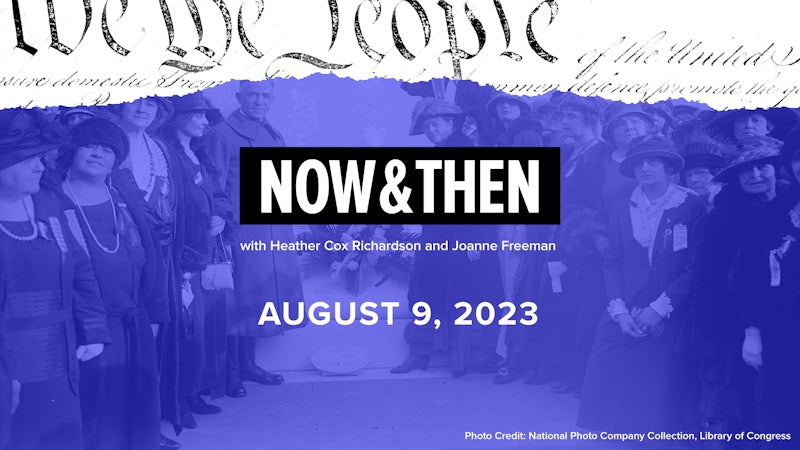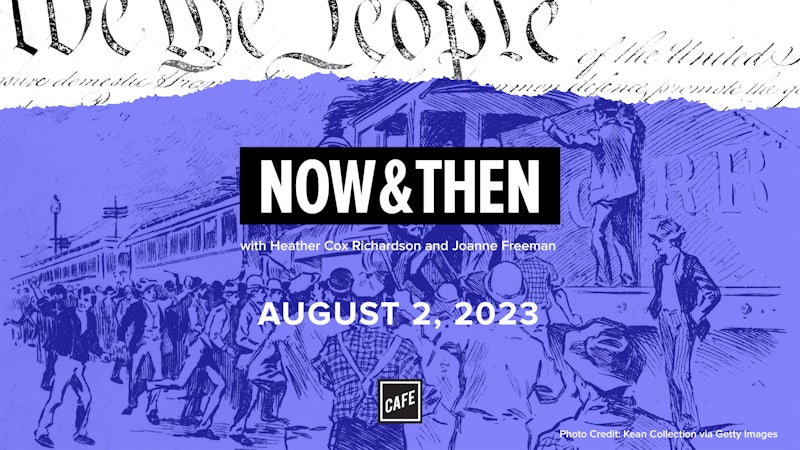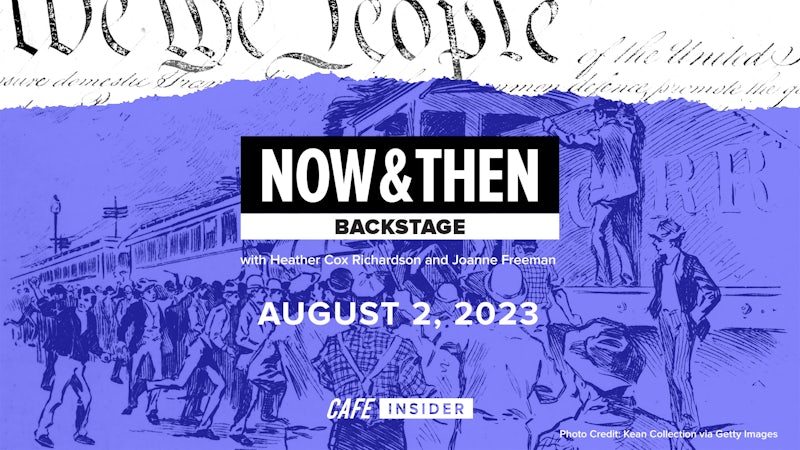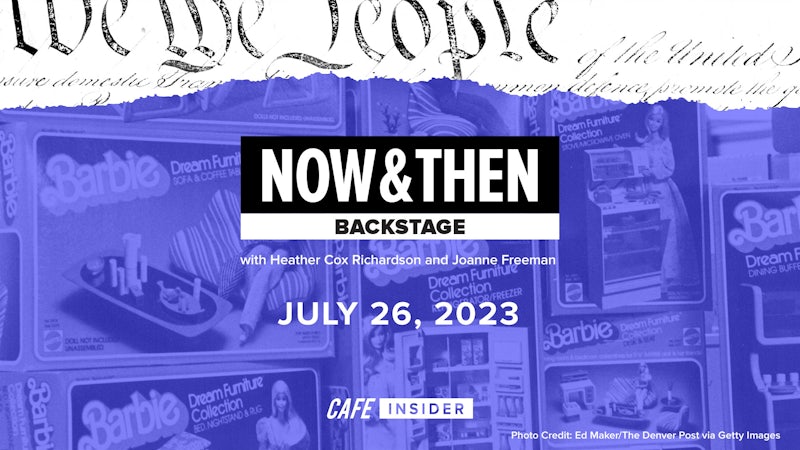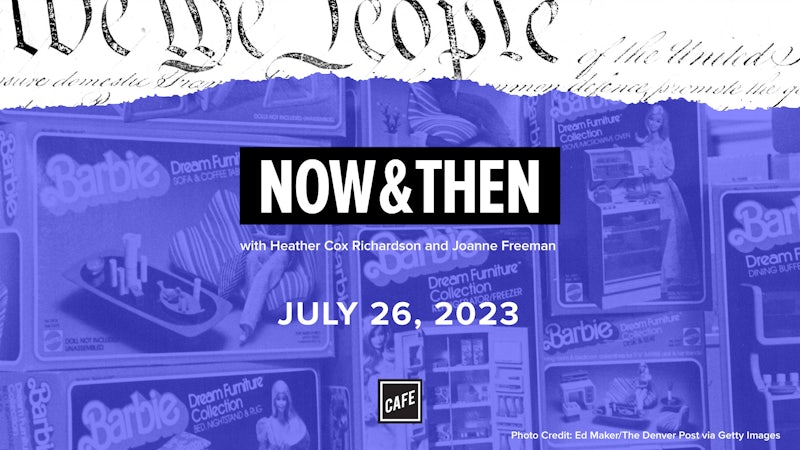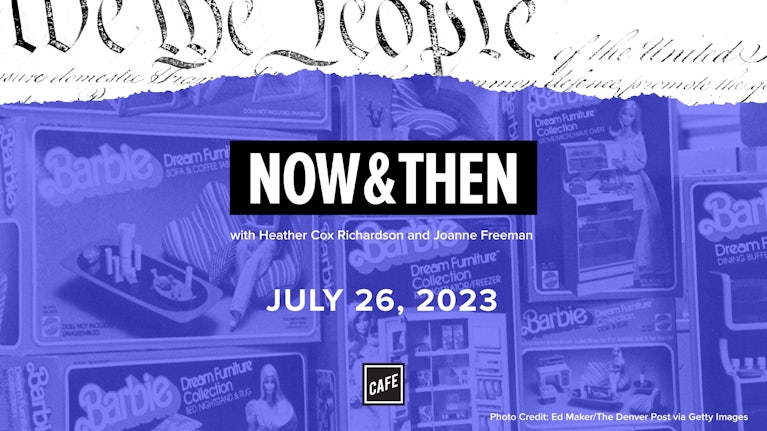Heather Cox Richardson:
From CAFE and the Vox Media Podcast Network. This is Now & Then. I’m Heather Cox Richardson.
Joanne Freeman:
And I’m Joanne Freeman. Today we’re going to talk about a topic that I suppose you could say, mythically speaking, is bigger than life. And that is the state of Texas. In many ways, in America’s sense of itself, in a kind of mythic way, Texas looms large. And Texans themselves have pretty distinctive ideas about themselves and their rights which migrate into American culture as a whole. So looking at Texas is partly looking at American identity writ small, partly looking about America and history and myths.
And the reason we’re talking about this today is because there’s a lot going on in Texas recently. Most specifically, there was the recent, unusual and, I suppose, in some ways, unexpected impeachment of the state’s Republican Attorney General Ken Paxton by Republicans. And he is on the brink of being removed from office by members of his own party. And he appears to be, in defending himself, tapping into this sort of mythologized version of Texan’s independence.
Heather Cox Richardson:
So Paxton is an interesting example of exactly what you’re talking about, Joanne, because he has always been a right-wing firebrand. He has been a fixture in state politics for a long time. He was first elected to the state legislature in 2002, and elected to the attorney general’s office in 2014. But nearly for the entire time he has been attorney general, he has been under indictment for securities fraud since 2015. And it comes from the charge that in 2011, he solicited investments for a technology company without registering as an investment advisor and without disclosing that he was receiving a hundred thousand shares in exchange for that. So this was all while he was a sitting member of the Texas State House.
He’s indicted in 2015. That’s right. And so far, that case has not gone to trial. But that’s not actually why Paxton is in trouble. It’s not the reason he’s in trouble now. He’s in trouble now because of corruption allegations. The Republican state representative in charge of a bipartisan house investigating committee that’s dominated by Republicans produced 20 articles of impeachment that relate to Paxton’s conduct before and during his time in office. They relate in part to his alleged efforts to protect a wealthy donor from an FBI investigation, and then his attempts to block whistleblower complaints by his staff. The story itself is sort of epic, really. But the thing that we wanted to emphasize today is that obviously Paxton is sketchy, let’s say, and sketchy enough that other Republicans have finally called him out.
But what’s interesting about this is that Paxton is in trouble with a Republican-dominated legislature. These are Republicans who have gone after… Mind you, the Democrats have been saying for a long time, “Come on. The attorney general’s under indictment, let’s do something.” And that was since 2015, but nothing happened until very recently when the Republicans turned against him. And when they did, Paxton called his impeachment, this is a quote, “a politically motivated sham” and said that the, quote, “RINOs,” that is Republicans In Name Only, “in the Texas Legislature are now on the same side as Joe Biden.” Okay, so it’s his own party that’s doing this. But he is claiming that the RINOs, as he calls them, are working with Democrats. And this is a quote, “To sabotage the attorney general’s offices legal challenges to Biden’s extremist agenda.”
He said on May 27th, “Every politician who supports this deceitful impeachment attempt will inflict lasting damage on the credibility of the Texas House which I served in. The house is poised to do exactly what Joe Biden has been hoping to accomplish since his first day in office. Sabotage our work, my work as Attorney General of Texas. Their plot,” interesting word, “imperils critical litigation my office has brought against the Biden administration to end the federal government’s attacks on our constitution and the rule of law. There is no other state in this country with so much influence over the fate of our nation, and this is solely because of the relentless challenges I bring against Biden’s unconstitutional agenda. I’ve sued Biden over 50 times and his unlawful tyrannical policies.”
Joanne Freeman:
The fact that you used the word actually epic as far as some of the alleged crimes he’s committed, but epic is the word because that’s kind of what he’s saying here too, right? My attacks, I have done this. I am helping to save America. And it’s all because all of these people that are actually on my side, but I’m going to pretend that they’re on the other side so that there’s an army against me. They are all out to get me. The undertoe of that, the idea being you need to stand behind me because this is yet another attack on Texas from, fill in the blank. The federal government maybe, writ large and small.
Heather Cox Richardson:
And I particularly love this because by any standard, what Paxton is accused of doing is not small. Like 20 counts on top of the ones that were already out there, and the guy is supposed to be enforcing the law for the state is not a small thing.
Joanne Freeman:
Over the period of years, right?
Heather Cox Richardson:
Yeah.
Joanne Freeman:
This is a known behavior on his part with many, many, many examples. And the fact that with that history and that knowledge, he is setting this up to say, “They’re all out to get me and it’s a plot.” And standing up and offering that pose. And assuming clearly that that pose will be taken, the performance will be taken as a reality by some, that’s pretty remarkable.
Heather Cox Richardson:
Well, it is, and it also of course has been defended by people like Texas Senator Ted Cruz who called the impeachment proceedings a travesty, and former President Donald Trump who is of course running for office in 2024, put on his knockoff Twitter truth social, “Free…” I’m sorry. “Free Ken Paxton.” And he said he would fight the state representatives who voted for his impeachment. Now, in the vote the Texas House for impeachment, there were accusations that in fact Paxton was calling people up and threatening them if they voted for his impeachment. So again, the idea that this is a persecuted gentleman is playing to a larger-than-life myth that comes from Texas, and we’ll talk about that, but that it’s continued since at least the 1830s to have an outsized influence on the way we think about America and the way we think about politics.
Joanne Freeman:
I feel the need to add that when it comes to what we’re talking about here, performance and doing things purely for public impact, you have in Texas the ongoing shipping, for lack of a better word, of migrants to other states as, again, clearly a publicity statement of his ideas and ideals. As of late last month, Texas had bust over 19,000 migrants to major American cities, including two buses of people sent to vice President Kamala Harris’ house in Washington just a few weeks ago. And very recently, and it’s still unfolding now, there’s a story about 16, I believe, migrants who were sent on a private plane to California from Texas and their suspicion that Florida might be involved. But again, the fact of the matter is here, it’s an ongoing pose or posture or assumption that what Texas is justifies what Texas does.
Heather Cox Richardson:
So one of the things it’s worth remembering when we’re talking about this is that we are talking about a certain myth of Texas. It does not accurately reflect Texas history.
Joanne Freeman:
And actually that’s important because there are many in Texas that want it to be portrayed and seen as one big giant monolith of power, and it isn’t. It’s diverse. There are many different kinds of people and they don’t all agree, which seems like an obvious thing to state, but I think in the case of Texas it’s important to state it.
Heather Cox Richardson:
So the real start of the mythological vision of Texas for, at least today’s Americans, comes from the Alamo. The story of the Alamo is foundational to Western American history, much like the pilgrims and the Mayflower are foundational for Eastern American history. But the stories that they tell are dramatically different. The story behind the eventual siege of the Alamo mission in 1836 is actually important for the way we understand what happened there. So what happens is when Mexico gains independence from Spain in 1821, one of the things that it wants to do is stabilize its northern borderlands which are covered by the Comanches who have an empire in that region called Comancheria. So they permit Americans to settle in what is now Texas. They had not been able to do so before that.
But by 1830, Mexicans decide to get rid of enslavement in Mexico. Now, southern Americans have started to move into those borderlands of Texas in order to grow cotton, and the cotton economy depended on enslaved labor. So the idea of getting rid of human enslavement in what lands that were then Mexico is a complete anathema to the American cotton growers who have moved into those borderland regions. So at the same time, the Mexicans who don’t like that current government of Mexico and its decisions for things like getting rid of enslavement, want to overthrow that government. And they start to organize with Americans to oppose the government of President Antonio Lopez de Santa Anna. And together, those group of Texians, as they were known, are going to make a stand against the Mexican government.
So that’s the background of what’s going to happen at the Alamo. There are Euro-Americans and Texians who oppose Santa Anna’s government and who are going to try to take over the lands in the eastern part of Texas in order to guarantee the continuation of human enslavement and the cotton economy in those regions. So that’s the background, but that’s not the myth.
Joanne Freeman:
And I feel the need to add in to the background. At a certain point, Mexican officials became concerned about, obviously, American attitudes in the region. And so the legislature passed the law of April 6th, 1830, which prohibited further immigration by US citizens. And to do that, the government put people along the region to monitor immigration and make sure that Americans weren’t immigrating into Mexican territory. Which I just feel the need to say because you come across a fact like that and you reveal not only does history sort of reverse itself, but there are any number of ways in which the irony of that slaps you in the face.
Heather Cox Richardson:
And one of the things that’s so incredibly cool about southwestern history is that it is such a tangle of moving borders and moving peoples and moving empires that the reduction of that incredibly complicated history to the Alamo is especially interesting really, because, I don’t know, it just feels like stuffing an octopus into a string bag or something.
Joanne Freeman:
The ultimate irony here, and I’m sure we’re going to be talking about it again in this episode, we’re talking about really this large multi-angled struggle in this period over what ultimately becomes the United States. But on a smaller level, we are talking about what is democracy, what kinds of rights do people have in different areas, the relationship on that border between different kinds of peoples. It’s complicated. It’s diverse. There’s all kinds of things happening. And what I’m about to tell you is the myth of the Alamo that erases all of that in favor of what is often called, and we’ll come back to this, a heroic narrative.
So a key figure and what becomes the siege of the Alamo is Stephen Austin. His father, Moses, received a land grant in 1825 from the newly independent Mexican government to move some families to Texas. Then as we mentioned earlier, in 1830, the Mexican government passes a law that says no more immigration of American citizens into Texas. Things are becoming more tense. Stephen Austin, who takes over that land grant from his father, heads to Mexico first to see if he can ease those restrictions, but he’s arrested by Mexican authorities. So after almost two years, he’s released and he returns to Texas where now things are becoming a little bit more war-like when it comes to Mexico and Americans, and which Americans are going to be, or any, are going to be allowed into the Texas territory.
Heather Cox Richardson:
First what happens is in October of 1835, the Texians go to war against Santa Anna’s troops and they push Santa Anna’s troops out of the territory known as Texas. Mind you, again, it’s part of Mexico. And then they hunkered down near San Antonio in the Alamo mission. Reinforcements are going to come in January of 1836. So in January of 1836, the reinforcements who arrive include James Bowie, the father of the Bowie knife, although he actually didn’t make the Bowie knife originally. He is famous because he killed a sheriff with a knife when he lived in Louisiana. He was actually himself from Kentucky. But in ’36, he was a Mexican citizen and he was married to the daughter of a high-ranking Mexican government official. Also coming for in that series of reinforcements was David Crockett. And David Crockett was formerly a congressman from Tennessee. And he and about 200 other Texians are going to hunker down in the Alamo when there are about 1,500 of Santa Anna’s troops coming toward them.
Joanne Freeman:
So in February of 1836, President General Santa Anna marches across the Rio Grande and heads towards San Antonio de Bexar. There’s a small group of people who are at the Alamo. They’re badly outnumbered. General William Travis, who is leading the men in the Alamo, recognizes that the Texians are very badly outnumbered, calls for reinforcements, but basically resolves to fight and writes a letter asking for reinforcement, offering these lines, which I gather have been much repeated for many obvious reasons. Travis writes in this letter, “If this call for reinforcements is neglected, I am determined to sustain myself as long as possible and die like a soldier who never forgets what is due to his own honor and that of his country. Victory or death.” You can just put the word heroic over that. So on March 6th, 1836, after a 13-day siege, Travis and those fighting alongside him died defending the Alamo after General Santa Anna’s troops breached the mission, get inside.
Heather Cox Richardson:
Or at least that’s the way the myth goes.
Joanne Freeman:
Correct. Texians leaders converged and did what happened actually a number of times in early America earlier than this. They declared themselves an independent republic. There are other parts of the United States, Vermont, North Carolina, much earlier do the same thing. It’s very much in the American spirit. And the siege set up a chance for the Texians to get revenge. So at this point, Commander Sam Houston ambushes Santa Anna’s troops, routes the Mexican army and ends the conflict. So now we have the Independent Republic of Texas. It will be an independent nation for the next 10 years, until 1846 when the United States annexes Texas as a state. That’s the story complete with the heroic words that I read from Commander Travis about what supposedly happened at the heroic stand at the Alamo.
Heather Cox Richardson:
Well, in that myth, that history, as it gets told from that moment forward, really emphasizes the idea that the people who are defending the Alamo are Anglos. The Mexican Texians get written out of the story. And the idea that they were defending enslavement is also written out of the story. In this case, they’re making, you used the word heroic and that matters, they’re making a last stand against-
Joanne Freeman:
An encroaching government.
Heather Cox Richardson:
Yes.
Joanne Freeman:
A country coming to stamp them out, and they are taking a stand to insist that they have a right to be on that land.
Heather Cox Richardson:
In the myth about the idea that they all died at the Alamo. Again, this great last stand. And yet, we now know historians have now established that in fact, David Crockett, as he was known then, not Davy, did not in fact die at the Alamo. He surrendered. He was killed later on the orders of Santa Anna. But the idea of Crockett surrendering was so offensive when that information was first established. One of the historians who established that actually got hate mail and people were attacking him for destroying this myth. And he is like, “I’ve got the documents. I got receipts here.” But a lot of people, not only in Texas but in the country, did not want to hear that the Alamo was really a battle in which one of their heroes surrendered and was later executed.
Joanne Freeman:
A complex battle in which different things happened and the human will. Some people behaved well, some didn’t. Some were caught up in the moment and it wasn’t a simple, easy, heroic narrative. Gasp.
Heather Cox Richardson:
And the fact that it was also about extending and preserving human enslavement is crucially important not only to that moment, and it’s worth taking a look at the numbers involved here. Austin was deeply involved in the attempt to continue enslavement in Texas. He lobbied Texas. He tried to come up with paperwork that would enable them to include or extend enslavement in Texas. And one of the complaints that a number of enslavers had from the American south in the 1830s is they didn’t want to emigrate to Texas until they were sure they would be able to keep their enslaved neighbors.
One Alabama planter said, “Our most valuable inhabitants here are enslaved.” I keep calling them enslaved neighbors because I like to emphasize this is not property, these are people. And he said, “Our planters are not willing to remove unless they can be assured of their being secured to them by Mexican laws.” So by 1826, 25% of the 1,800 United States settlers in Texas were enslaved. Austin deliberately wanted to protect it.
Joanne Freeman:
And said so bluntly. And this is hard to be more blunt than this. He wrote in 1833, “Texas must be a slave country. Circumstances and unavoidable necessity compel it. It is the wish of the people there and it is my duty to do all I can prudently in favor of it. I will do so.”
Heather Cox Richardson:
I just love that. It is the wish of the people there. Which people?
Joanne Freeman:
Well, yeah. Now Santa Anna actually in 1836, along similar lines here, he writes to a leader in the Mexican Congress and suggests that abolishing slavery was one of the central reasons for his personal role in the attack on the Alamo. He says, “There is a considerable number of slaves in Texas who have been introduced by their masters undercover of certain questionable contracts, but who according to our laws should be free. Shall we permit these rushes to moan in chains any longer in a country whose kind laws protect the liberty of man without distinction of caste or color?”
John Quincy Adams at the time, who, after his presidency, goes back to the house, agrees that this is about slavery. And of course he’s an adamantly anti-slavery member of Congress. He says in 1836, “The war now raging in Texas is a Mexican Civil War and a war for the reestablishment of slavery where it was abolished. It is not a servile war, but a war between slavery and emancipation, and every possible effort has been made to drive us into the war on the side of slavery.” Now I feel the need to say here because what I’m thinking of is the tendency of some people to hear the demythologizing of myths in the way that we’re doing it here. And to hear that as saying, “There’s nothing good. There’s nothing worthwhile. There’s nothing of merit happening in the history of this moment. It’s all bad.”
And I guess I want to say as a historian, what we’re saying is that the truth is more complex and it’s not all good. If you’re whitewashing the narrative as a heroic narrative, you’re not only doing an injustice to the people who are kept out of that narrative, but you’re doing an injustice to the people who are in it because they’re in far more complex circumstances fighting with and against far more complex situations. You can’t understand what anyone is doing in this period without acknowledging the complexity of it.
Heather Cox Richardson:
Well, and I would push that forward and say the reason we care about this is because I would argue that one of the real hallmarks of Texas history has been that it relies largely and has relied even before the United States got involved on extractive economies that tend to elevate a very few men, and they’re almost always men, to be in economic and political power. When the reality of life in Texas was always about trade. It was always about intermarriage. It was always about communities. And that history of communities, which has been really well established, has largely been forgotten. And that matters now because it’s not just that the past was complicated. But that if you misunderstand our past, you try to create a future that is completely unrealistic.
If you take out of Texas history, the kinship networks, the intermarriage, the actual labor, all of the things that made society go, you’re left with a bunch of guys running around who are completely divorced from any kind of society or reality. When people look at Texas nowadays and try to say, “Oh, it’s all about heroic men making a stand for freedom,” it simply is like taking a look at a painting through a little teeny-tiny jewel’s loop and saying, “This is what really happened.” And it’s not a painting, it’s not viable on its own at all. So the myth really matters because the myth is a political stand, a political whitewashing of what life really is.
Joanne Freeman:
And what that battle really was, and what its implications and impact were.
Heather Cox Richardson:
And again, it’s not just about history, it’s about recently the governor of Texas, Greg Abbott, has fought to keep the description of the Alamo as heroic in state textbooks. And all that that implies, the Alamo myth becomes a story of Euro-Americans, the Mexican Texians are erased, who are fighting for freedom, when in fact they’re fighting for the freedom to enslave their neighbors so that they can continue to take advantage of an incredibly profitable extractive economy. And the myth is an important part of that story, but it’s not reality.
The reality of that moment is one, I think, that speaks to a lot more of us than those of us who would like to see that as some great heroic moment. That idea that Texas stands for freedom against a grasping government, that mythology that comes out of the Alamo is everywhere in the late 19th century. And of course we’ve talked about how it’s behind the cowboys. It’s going to continue over water rights, it’s going to continue over cattle, and it’s also going to continue over the idea of oil and what the Texas oil boom says about freedom and about the relationship between individuals and the government.
Joanne Freeman:
This brings us to another big story associated with Texas that also gets bound up with some of the mythmaking about Texas, and that is the Texas oil boom. This idea of, “Go out to Texas and become rich with the geysers.” And sort of, “Go west, young man, and become rich.” There’s a thread of that in this as well. In truth, it’s not people going out and finding oil and becoming rich and being heroic, independent men who are making it on their own and capturing the American dream as we just suggested, it’s a lot more complicated. It has to do with wild cat oil drillers with regulators. It has to do with the state trying to pass regulations and people not really wanting to abide by those regulations. And it has to do with people left without resources while other people are really scrambling for oil.
Now, in the early 1890s, drillers discovered the first significant oil reserve in Texas at the East Texas Corsicana Reserve. And at about the same time, a speculator from Texas named Pattillo Higgins purchased Spindletop Hill near his hometown, convinced that there was oil under the hill. And for nine years he tried and failed to locate oil, that’s determination, from that purchase that he made. Eventually he brought on an advanced driller named Anthony Lucas and they used capital from the oil-rich Pennsylvania from investors there to drill deeper into the hill and struck oil in January of 1901. And that gusher, the Spindletop gusher, shot a hundred feet into the air for nine straight days. You can imagine every movie you’ve ever seen that shows that scene in it. “Oil. We got oil.”
Spindletop began producing 70,000 to 100,000 barrels of oil per day, making it far and away the most productive well in the world at the time. Now, obviously an oil rush is now on. Although Spindletop dries up within two years because it’s being milked for its oil in irresponsible ways.
Heather Cox Richardson:
Have you ever seen those early pictures of Spindletop?
Joanne Freeman:
No.
Heather Cox Richardson:
It looks like a forest of wells, like everybody wants in. They look like trees. There’s so many of them, it’s just a whole wall of oil wells. Now, we almost don’t have to say what happens because the history does have patterns. There’s a lot of money to be made if you have the money to drill. It’s not like you can get out there with your hand drill and do this, or your shovel. You need capital to drill. You drill, there is oil pouring out of the ground, everybody wants in. They’re producing huge amounts of it. So what happens? By 1930, East Texas is producing one-third of the oil in the United States, 1,200 oil fields pumping out almost a million barrels a day.
Joanne Freeman:
When you have that amount of oil being pumped out, it causes a glut which backfires. And after reaching a peak of over a dollar a barrel in 1930, oil fell to only 8 cents a barrel in 1931. And of course that’s bound up with other things that are happening in what is now the Depression era. So again, this is going to be a logical part of the story. To protect the oil industry, the Texas Railroad Commission that controls oil production orders strict production limits. And also somewhat predictably, many oil companies disregarded the commission’s order.
So Texas Governor Ross Sterling sends in the National Guard to guard against illegal oil drilling and production saying in a Marshall Law order that those who disregard the government’s mandate are in a state of insurrection. There’s that word. He says, “It is evident that there exists an organized and entrenched group of crude petroleum oil and natural gas operators who are in a state of insurrection against the conservation laws of the state relating to the prevention of waste of crude petroleum oil and natural gas, and are an open rebellion against the efforts of constituted civil authorities of this state to enforce such laws.”
Heather Cox Richardson:
This always makes my head explode because this happens in the West and in Texas again and again and again. It happens with cattle. It happens with water. It happens with oil. It happens with all of these extractive economies. You get these big guys going in. They start to make bank, and they see themselves as independent operators. And they inevitably get themselves into… It was my mother would’ve called it a mell of a hess.
Joanne Freeman:
I like your mother, Heather.
Heather Cox Richardson:
Finally. Exactly. She’d liked you too, by the way. And finally, the regulators come in and they’re like, “Okay, we’re going to clean this up.” And as soon as regulators come in and try to clean things up and they manage to stabilize the economy, all of a sudden those operators snap back to, “we’re independent. We want our freedom. You need to get out.” And this is, honest to God, a theme that runs absolutely through this region. And I think it stems from that myth, the idea, “We are these heroes. Doing it on our own. And get that government out of our faces.” Except, oopsy poopy, when we destroy our economy, our environment, our people, then we’re more than happy to have help. Oh, but then you need to go away again so we can do it all over again.
Joanne Freeman:
You can’t tie everything back to one myth. But you can say that the thread of thought, the idea, the sort of ethos encapsulated in the Alamo myth and repeated again and again and again in a variety of ways is, again, independent people heroically taking a stand against authority in some way or another. And by definition, it’s heroic.
Heather Cox Richardson:
So what happens is when the big guys refuse to stop, the people in Texas who are hurting so terribly badly during the Depression actually say, “All right, we’re going to do it ourselves. If the government’s not going to do it, we’re going to take matters into our own hands.” So a major general of the Texas National Guard, the guy who was in charge of enforcing martial law over the oil fields, a man named James Walters, wrote to Governor Sterling about the fact that people were threatening vigilante violence to protect the oil fields from the oil companies who were ignoring the production limits, and that they were begging for stronger government intervention.
Walters wrote, “The feeling is very strong, Governor. All day men have openly said that if the governor could not hold the field down, they were going to take charge of it themselves. Hang a few SBs,” I’m going to go with that meant sons of bitches,” and if necessary, dynamite pipelines and save this field from destruction, and save the oil industry.” And the state does in fact pass Market Demand Act which gave the Railroad Commissioner full control over production standards across the state by late 1932. And Sterling says, governor of Texas says, “From now on there will be none. That is no oil or gas taken without the consent of the state.”
Joanne Freeman:
The Railroad Commissioner Ernest Thompson explains why this new law was so difficult for smaller oil producers to initially accept and why government control over oil would help stabilize the economy. So help others, not just the people who are out there doing the drilling. Thompson said, “People have so long thought that it was their proud privilege to do whatever they desired with whatever they owned. That it is hard to get them to understand that to do as one pleases with one’s property carries with it the correlative duty to do no violence to the rights of others.” What a concept. That when you are doing what you are doing, that there are repercussions and you are being able to do what you want to do. You can’t be so free that you are actually doing violence to the rights of others.
And this ongoing battle over the flow of oil continues on into the 1940s and spawns a number of Supreme Court cases. So it’s an ongoing issue, but still that myth of the independent oil drillers sort of doing what they want to do and fighting off big government. It is worth also noting that the whole oil story and the mythology associated with it is also a way to applaud capitalism. The government is tamping down on us. Look what happens when you let people go and develop things and get big money. As you put it, the oil story, tying into another sort of mythic part of American identity which is the sort of amazing wealth and capitalism run amok. That’s important to tie in here too.
Heather Cox Richardson:
Capitalism run amok, but also who gets to have a part of that? This idea of Texas as myth, it’s going to be hypercharged in the 1950s when we get the second civil rights movement and the idea that the government is going to level the playing field for at least Black Americans and soon brown Americans and later women. Then the idea of this west as being this place of freedom where men can make it on their own, so I say become sort of hypercharged. So we’re going to have it bleed into popular culture pretty dramatically beginning in the 1950s and becoming a really major deal in the late 1970s.
Joanne Freeman:
Now I feel the need to, before we plunge into that, mention, that the myth of Texas in film dates back earlier than the period that we’re talking about. And someone who we’re not going to go into in detail, but who deserves mention here is John Wayne who made at least 200 movies. And apparently, in half of them, he’s a Texan. So that image you have of John Wayne, the sort of lone man out there fighting for what’s right with integrity and whatever else, fill in the adjectives, John Wayne was helping to create that image and to perpetuate that image of what a Texan is.
One other thing I want to mention before we get to big modern Hollywood films is that there actually were some movies about the Alamo. So if we’re talking about Hollywood and the Alamo, and there’s even a little bit to talk about there. But of course between 1915 and the 1950s, when you saw movies about the Alamo, they went right back to what we were talking about as the myth. You had Anglos who were always had intense integrity, and anyone who was Mexican was degenerate, cruel or cowardly. So the myth was there in film at a very early point and continued.
So let’s go on to talk about a movie that is particularly famous for being of this ilk, and that is the movie Giant which is a movie about the Texas oil boom ties into some of that mythmaking. It was based on a book written by Edna Ferber, a New York based author in 1952. And it talks about rivalry between the cattle-ranching Benedict family and the oil-drilling Rink family. The book basically follows patriarch and rancher, Bick Benedict, his wife Leslie and their rival, Jett Rink, who is a one-time handyman but becomes wildly successful in the realm of oil. And the book offers this kind of rough and tumbled depiction of Texas and this idea of freedom, what that means in the state.
Early in the narrative, Bick proclaims the virtues of living in Texas, which is right along the lines of what Heather and I have been talking about. If it’s freedom you want, come to Texas. No one there tells you what to do and how you have to do it. Ferber also talks about class, the question of class in the dynamics of Texas comparing the oil rush in Texas and all of the massive waves of capital coming from it to the merchants and barons of New York. That same character, Bick Benedict, there’s too much fun to say that name, says, “Here in Texas the cotton rich always snooted the cattle rich. And now if this oil keeps coming into Texas the old cattle crowd will look down their noses at the oil upstarts. You know, like the old New York De Peysters snooting the Vanderbilts, and the Vanderbilts cutting the Astors.”
So she’s talking about in her book Unfettered Capitalism, she’s talking about class and there is also a race component in her book. There’s a scene in the book in which Bick Benedict, who’s the patriarch of the formerly leading family, is denied service at a diner because the proprietor thinks that he looks Mexican. And so then there’s a discussion here in the book of not wanting to serve Mexicans. Again, race gets brought into this as well.
Heather Cox Richardson:
The older money starts to recognize the lack of equality in this get-rich-quick society. And in the book, he is denied service because people think he’s Mexican. But when they make a movie out of it, in 1956, Rock Hudson played Bick, Elizabeth Taylor played Leslie, and James Dean, which was actually his last role before he died in a car accident, played Jett Rink.
Joanne Freeman:
In the film, instead of having Benedict himself be denied service because he looks Mexican, they change it. And instead, they have a Mexican-American family denied service. And it’s sort of a moment of showing the Benedict family the old-money being pushed aside in the film. Benedict says…
Bick Benedict:
Now look here, Sarge. Sure appreciate it if you’re a little more polite to these people.
Speaker 4:
Oh, you would, would you?
Bick Benedict:
I’m Bick Benedict. Your neighbor, you might say.
Speaker 4:
Does that give you special privileges?
Bick Benedict:
Well, name Benedicts meant something to people around here for considerable time.
Joanne Freeman:
So the focus now becomes on what you just said, Heather, the idea that the old-money is being pushed aside in favor of the new-money.
Heather Cox Richardson:
That focus and also the understanding that racism affects everybody is replaced by the white savior narrative. No longer does he have skin in the game, now he’s just saying, “Can’t you be nice to these people?”
Joanne Freeman:
And also puts him down less sharply than Edna Ferber did in her book, right? If someone says, “Oh, you look Mexican,” that would be taken as an insult. And here just as you said, he’s being elevated in this moment. But you got to let me do the scene only because I’ve talked about it and now I get the chance to read it from the script of the moment when James Dean strikes oil and he says, “I’m rich, Bick. I’m a rich boy. I’m going to have more money than you ever thought you could have. You and all those stinking sons of Benedict.”
Heather Cox Richardson:
So that particular book and movie about oil is a moment, but I have been holding my breath waiting for this particular moment. And this is a fun thing to talk about for me because I have never seen it, I have only studied it. So I’m like the Martian who has arrived from a hundred years in the future, talking about the importance of something that happened in April of 1978. And since Joanne was there, I will let her take it away.
Joanne Freeman:
Wow. I did watch it and I remember parts of it. It was not highly influential on my youth, but still, many, many people who were around in the ’70s will remember the prime time soap opera, Dallas. It actually ran for 14 seasons, and it shows the crazy lives of the Ewing family, which is a powerful Dallas family, and they are in control of the massive Ewing Oil. Now, the most famous thing about the show is of course the famous cliffhanger at the end of season three in 1980, when family patriarch JR Ewing gets shot and the episode ends. And this idea, Who Shot JR?
Maybe you can think of, Heather, a modern equivalent for something like that, a TV show or a movie thing, or I guess now it would be a meme, that’s bouncing all over the place and everybody knows about it and it captures a moment. But Who Shot JR was everywhere. And the thing that I remember best about Dallas, and I suppose this is appropriate given the topic of our episode here, is the image and the ethos of it. The big clothes and the big shoulder pads and the big hair and the big money. It was a soap opera, but it was a soap opera of big oil people, people with massive amounts of excess wealth and what those people were doing. So you were watching it, but it wasn’t just a normal soap opera with people you could identify with. It was also these sort of big characters doing things that people with big money in that way could do, and it was all due to oil.
Heather Cox Richardson:
I remember that very well because it seemed cartoon-like to me in the world I was living in, even though again I never once saw it. What I saw was the ads. But the reason that I’m fascinated by Dallas the TV show is because it debuts in April of 1978, and then you get Who Shot JR in 1980. What else is going on then is of course the election of 1980, which is going to give us the celebration of Ronald Reagan who is from California and who really hits on that western mythology again and again and again and again. The John Wayne, the fact that he switches his writing style from the English writing style to the Western writing style.
To tie this back to this moment, in that election season, Republicans start to distribute buttons that read a Democrat shot JR. I mean, the idea that somebody took down this mythological, larger-than-life rich guy, everybody else is like, “Was it his-
Joanne Freeman:
His wife. His wife.
Heather Cox Richardson:
… mistress? Was his wife?” Yeah. And they’re like, “It was a Democrat.” Because Reagan’s idea of course, and what he was really pushing was the idea that a government, that regulated business, a government that defended the rights of people of color, those things would destroy that myth and destroy the people who lived in that myth. And so they actually distribute buttons that say, “A Democrat shot JR.”
Joanne Freeman:
So there you have the myth of the independent oil man out there fighting to have rights to produce what he wants to produce and make big money and not have big government looking down on you. And you have that sort of mythic TV, deliberately bigger-than-life character, yoked into actual politics. The actual and, of course, it makes perfect sense that this is Reagan putting the Democrats into that narrative. The Democrats are the bad guys who are out to get these oil people. The Democrats would be the ones who would come to get you. To me, part of what’s fascinating here is the fusion. We keep talking about myth and its impact on politics, and here we have politics like deliberately grabbing at the myth. It’s really kind of a remarkably powerful example of that.
Heather Cox Richardson:
Well, and it brings us full circle to Ken Paxton. This is a man who certainly appears to have committed a whole basket full of crimes. And instead of sort of putting his tail between his legs and saying, “Okay, I’m going to lawyer up and all that,” instead he says, “Oh, I didn’t do anything. It’s the Democrats.” Or “It’s the Republicans working with the Democrats.” And on a much larger scale, that’s exactly what former President Trump is doing, “I didn’t really commit crimes. It’s the Democrats are coming after me to destroy this myth of the heroic American.”
Joanne Freeman:
I am a heroic, independent American. I am standing up for rights. I am in the American tradition. And they, it has to be a big they, it has to be an impressive and powerful they to make you seem like the hero for standing up to it, that you are doing the right thing by standing up to it. Now in the case of Paxton, we’re talking about the law. He’s allegedly breaking laws all over the place, and as you said, he’s not putting his tail between his legs and slinking off. He’s not even saying, “I didn’t do it.” He’s saying, “They’re out to get me. The Democrats and disloyal Republicans, they’re out to get me. And look how brave I am and how independent I am and how I’m fighting for your rights like an independent fighter against the powers that be.”
And you’re absolutely right, that’s the Trump ethos as well. That same thing. Although Trump ads, I alone can do it, but still that is the Trump ethos of being this independent guy who’s out there fighting for you and fighting against big government. And the Democrats become part of that big other, the big enemies who are trying to bring him down. Both of these men are tying into what hopefully by this point in the episode, clearly is a really powerful, not only myth about Texas, but at this point, american myth. A myth about what is American, about American identity, about what is heroic or not heroic. And it’s powerful enough that it can be deployed deliberately in this way because it’s sure to have some kind of an impact. Americans, or at least a lot of them, will respond to that.
Heather Cox Richardson:
And looking forward, what fascinates me in this moment, and you can look at somebody like Paxton and say, “Will criminality, obvious criminality, finally break through that myth?” And of course, Paxton is one way to look at it. But will, going forward, if indeed the former president is indicted on yet more charges, once that people really see as extraordinary, will they finally say, “Nah, he’s not being persecuted. This is not-
Joanne Freeman:
Part of this.
Heather Cox Richardson:
… this is actual crime.” Reality is intruding, and I’m not sure.
Joanne Freeman:
I’m not sure either, but I do want to tie it back to what should be another core component of American governance and politics, and it goes directly against the myth that we’ve been talking about. And Newbie clearly agrees because I can hear him chirping away back there. That’s accountability, right? If you allegedly break the law and then you’re held accountable for it, that’s part of what democracy is grounded on. You give power to people, they’re accountable for how they use it. Accountability doesn’t go along really well with that myth of the independent man out there riding around, getting what he wants and doing what he wants and fighting for what’s right. It’ll be interesting. And like you, Heather, I have absolutely no idea what to expect and I’m not even going to try to say so, but that’s where we are. That’s where our narrative is at this moment.












